Abstract
Serum activity of alpha-N-acetylgalactosaminidase (NaGalase), the extracellular matrix-degrading enzyme that appears to be produced exclusively by cancer cells, was measured in mice bearing SCCVII tumours (squamous cell carcinoma). The NaGalase levels in these mice increased with time of tumour growth and were directly proportional to tumour burden. After exposure of SCCVII tumours to a single X-ray dose of 20 Gy, the serum NaGalase levels gradually decreased during the first 10 days after treatment (to approximately one-third of the initial value) and then began to increase. The decrease in serum NaGalase activity was more rapid after the treatment of SCCVII and EMT6 tumours by photodynamic therapy (PDT) and was dependent on the PDT dose. The treatments (based on photosensitizers Photofrin or mTHPC) that were fully curative resulted in the reduction of NaGalase activity to background levels within 2 or 3 days after PDT. A slower decrease in NaGalase activity was found after PDT treatments that attain an initial tumour ablation but are not fully curative. The regrowth of PDT-treated SCCVII tumours was preceded by an increase in serum NaGalase levels, which was detected as early as 8 days before the visible tumour reappearance. These findings ascertain the validity of serum NaGalase measurement for the assessment of tumour response to different treatments and support the concept that the NaGalase measurement could serve as a diagnostic and prognostic index that might allow oncologists to design the dosage or nature of treatment.
Full text
PDF
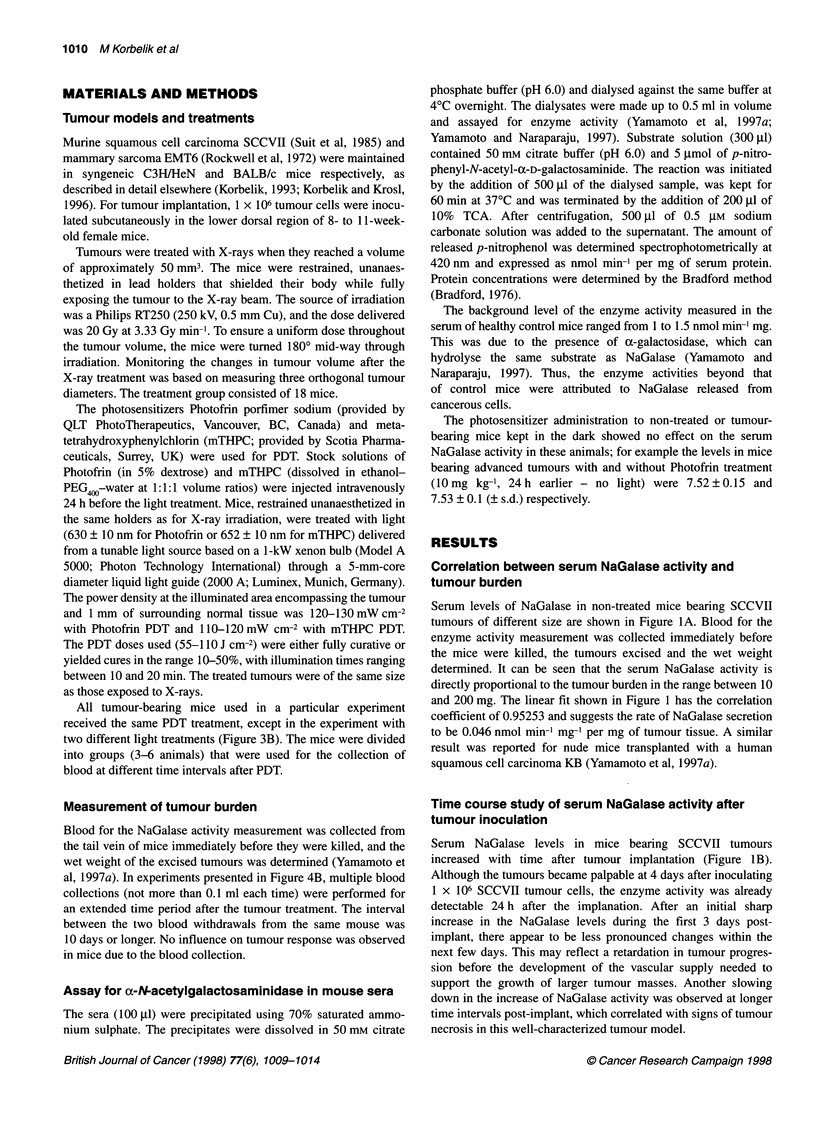
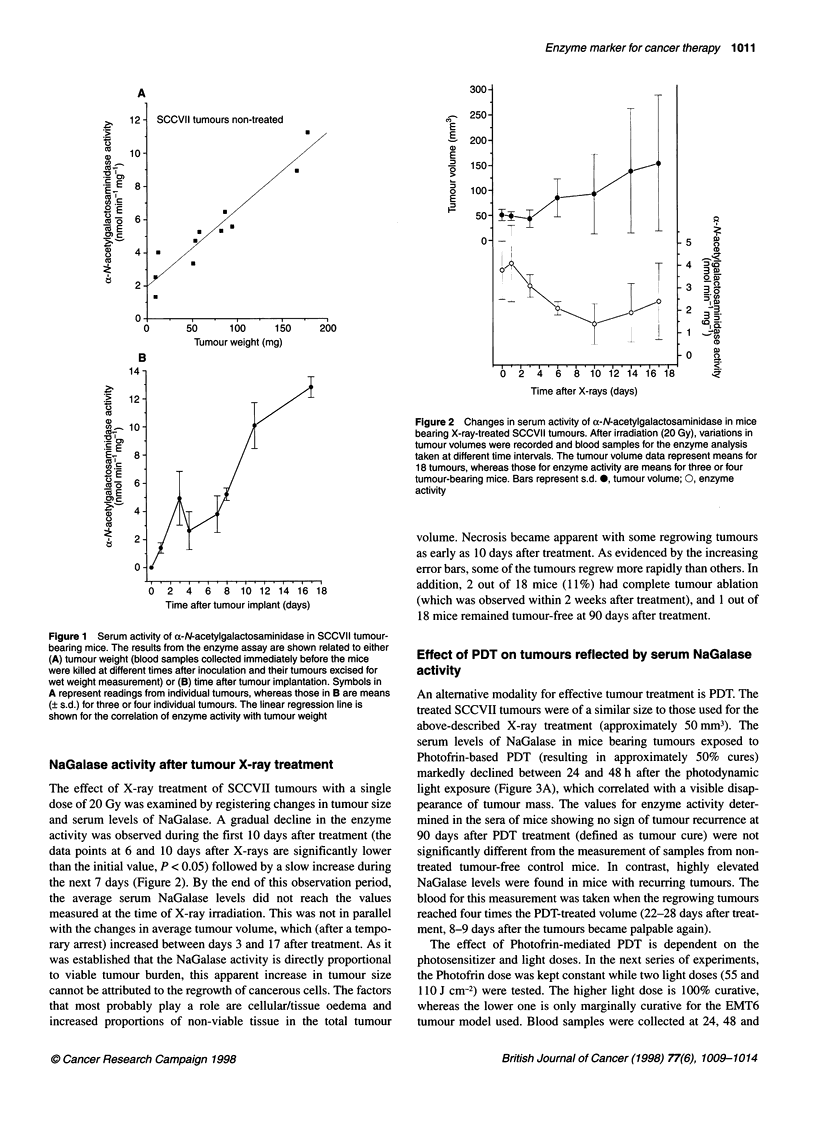
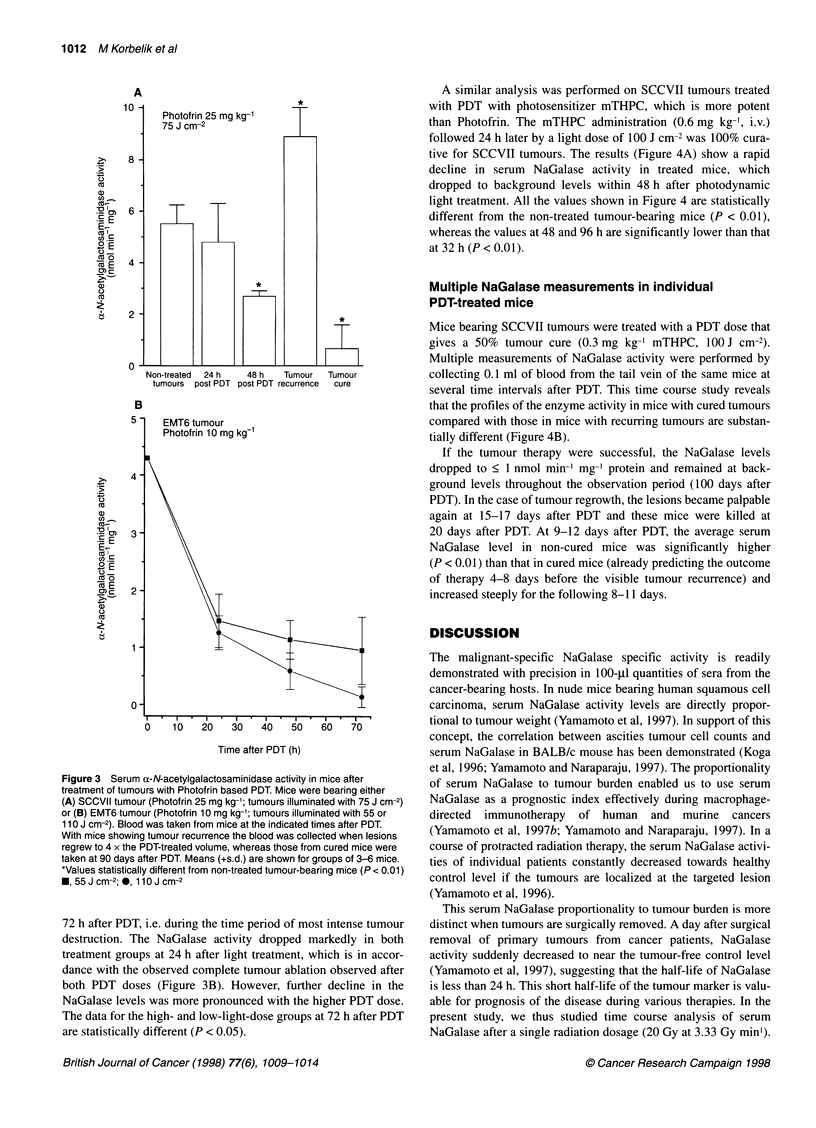
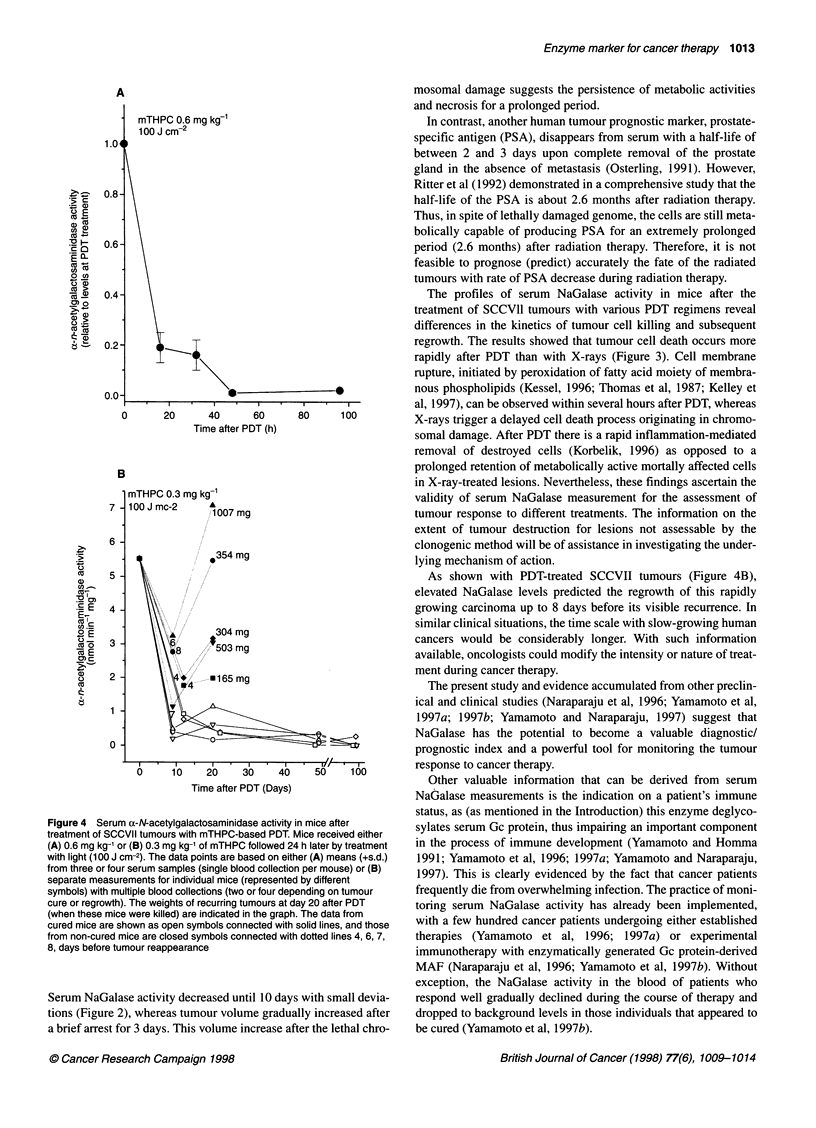
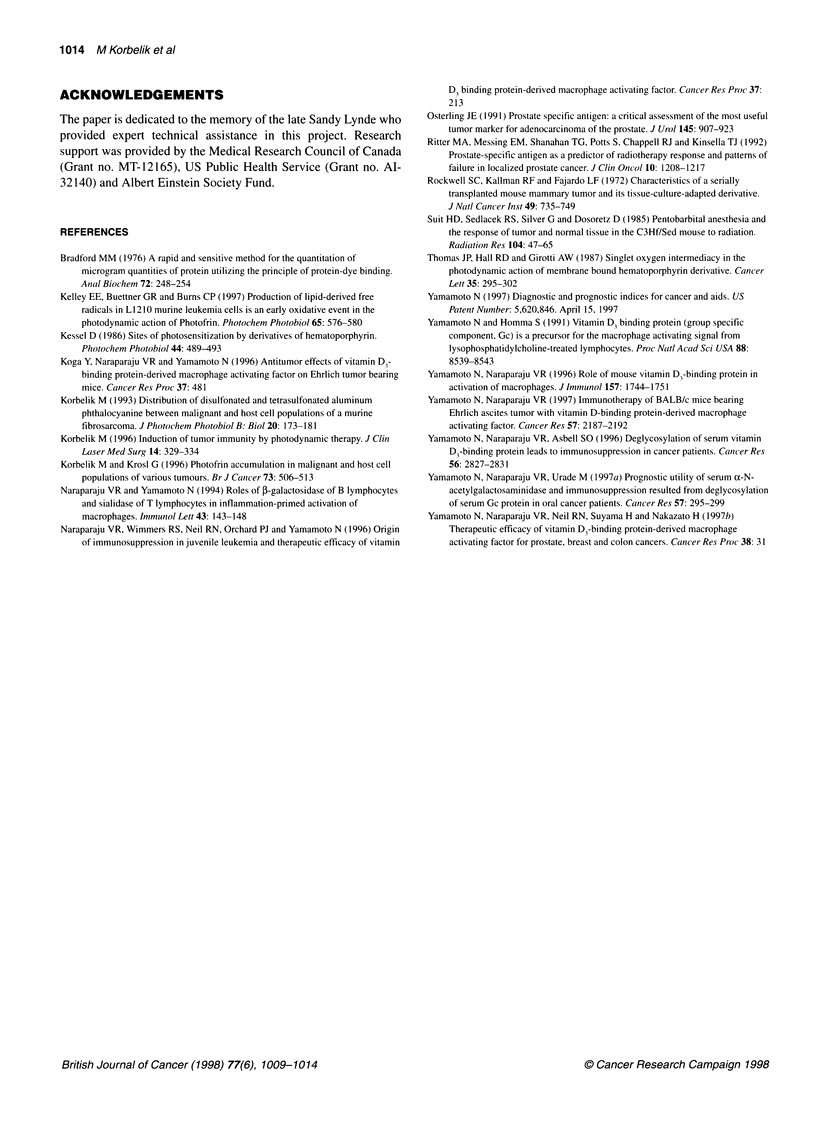
Selected References
These references are in PubMed. This may not be the complete list of references from this article.
- Bradford M. M. A rapid and sensitive method for the quantitation of microgram quantities of protein utilizing the principle of protein-dye binding. Anal Biochem. 1976 May 7;72:248–254. doi: 10.1016/0003-2697(76)90527-3. [DOI] [PubMed] [Google Scholar]
- Kelley E. E., Buettner G. R., Burns C. P. Production of lipid-derived free radicals in L1210 murine leukemia cells is an early oxidative event in the photodynamic action of Photofrin. Photochem Photobiol. 1997 Mar;65(3):576–580. doi: 10.1111/j.1751-1097.1997.tb08608.x. [DOI] [PubMed] [Google Scholar]
- Kessel D. Sites of photosensitization by derivatives of hematoporphyrin. Photochem Photobiol. 1986 Oct;44(4):489–493. doi: 10.1111/j.1751-1097.1986.tb04697.x. [DOI] [PubMed] [Google Scholar]
- Korbelik M. Distribution of disulfonated and tetrasulfonated aluminum phthalocyanine between malignant and host cell populations of a murine fibrosarcoma. J Photochem Photobiol B. 1993 Oct;20(2-3):173–181. doi: 10.1016/1011-1344(93)80148-3. [DOI] [PubMed] [Google Scholar]
- Korbelik M. Induction of tumor immunity by photodynamic therapy. J Clin Laser Med Surg. 1996 Oct;14(5):329–334. doi: 10.1089/clm.1996.14.329. [DOI] [PubMed] [Google Scholar]
- Korbelik M., Krosl G. Photofrin accumulation in malignant and host cell populations of various tumours. Br J Cancer. 1996 Feb;73(4):506–513. doi: 10.1038/bjc.1996.88. [DOI] [PMC free article] [PubMed] [Google Scholar]
- Naraparaju V. R., Yamamoto N. Roles of beta-galactosidase of B lymphocytes and sialidase of T lymphocytes in inflammation-primed activation of macrophages. Immunol Lett. 1994 Dec;43(3):143–148. doi: 10.1016/0165-2478(94)90214-3. [DOI] [PubMed] [Google Scholar]
- Oesterling J. E. Prostate specific antigen: a critical assessment of the most useful tumor marker for adenocarcinoma of the prostate. J Urol. 1991 May;145(5):907–923. doi: 10.1016/s0022-5347(17)38491-4. [DOI] [PubMed] [Google Scholar]
- Ritter M. A., Messing E. M., Shanahan T. G., Potts S., Chappell R. J., Kinsella T. J. Prostate-specific antigen as a predictor of radiotherapy response and patterns of failure in localized prostate cancer. J Clin Oncol. 1992 Aug;10(8):1208–1217. doi: 10.1200/JCO.1992.10.8.1208. [DOI] [PubMed] [Google Scholar]
- Rockwell S. C., Kallman R. F., Fajardo L. F. Characteristics of a serially transplanted mouse mammary tumor and its tissue-culture-adapted derivative. J Natl Cancer Inst. 1972 Sep;49(3):735–749. [PubMed] [Google Scholar]
- Suit H. D., Sedlacek R. S., Silver G., Dosoretz D. Pentobarbital anesthesia and the response of tumor and normal tissue in the C3Hf/sed mouse to radiation. Radiat Res. 1985 Oct;104(1):47–65. [PubMed] [Google Scholar]
- Thomas J. P., Hall R. D., Girotti A. W. Singlet oxygen intermediacy in the photodynamic action of membrane-bound hematoporphyrin derivative. Cancer Lett. 1987 Jun;35(3):295–302. doi: 10.1016/0304-3835(87)90131-5. [DOI] [PubMed] [Google Scholar]
- Yamamoto N., Homma S. Vitamin D3 binding protein (group-specific component) is a precursor for the macrophage-activating signal factor from lysophosphatidylcholine-treated lymphocytes. Proc Natl Acad Sci U S A. 1991 Oct 1;88(19):8539–8543. doi: 10.1073/pnas.88.19.8539. [DOI] [PMC free article] [PubMed] [Google Scholar]
- Yamamoto N., Naraparaju V. R., Asbell S. O. Deglycosylation of serum vitamin D3-binding protein leads to immunosuppression in cancer patients. Cancer Res. 1996 Jun 15;56(12):2827–2831. [PubMed] [Google Scholar]
- Yamamoto N., Naraparaju V. R. Immunotherapy of BALB/c mice bearing Ehrlich ascites tumor with vitamin D-binding protein-derived macrophage activating factor. Cancer Res. 1997 Jun 1;57(11):2187–2192. [PubMed] [Google Scholar]
- Yamamoto N., Naraparaju V. R., Urade M. Prognostic utility of serum alpha-N-acetylgalactosaminidase and immunosuppression resulted from deglycosylation of serum Gc protein in oral cancer patients. Cancer Res. 1997 Jan 15;57(2):295–299. [PubMed] [Google Scholar]


